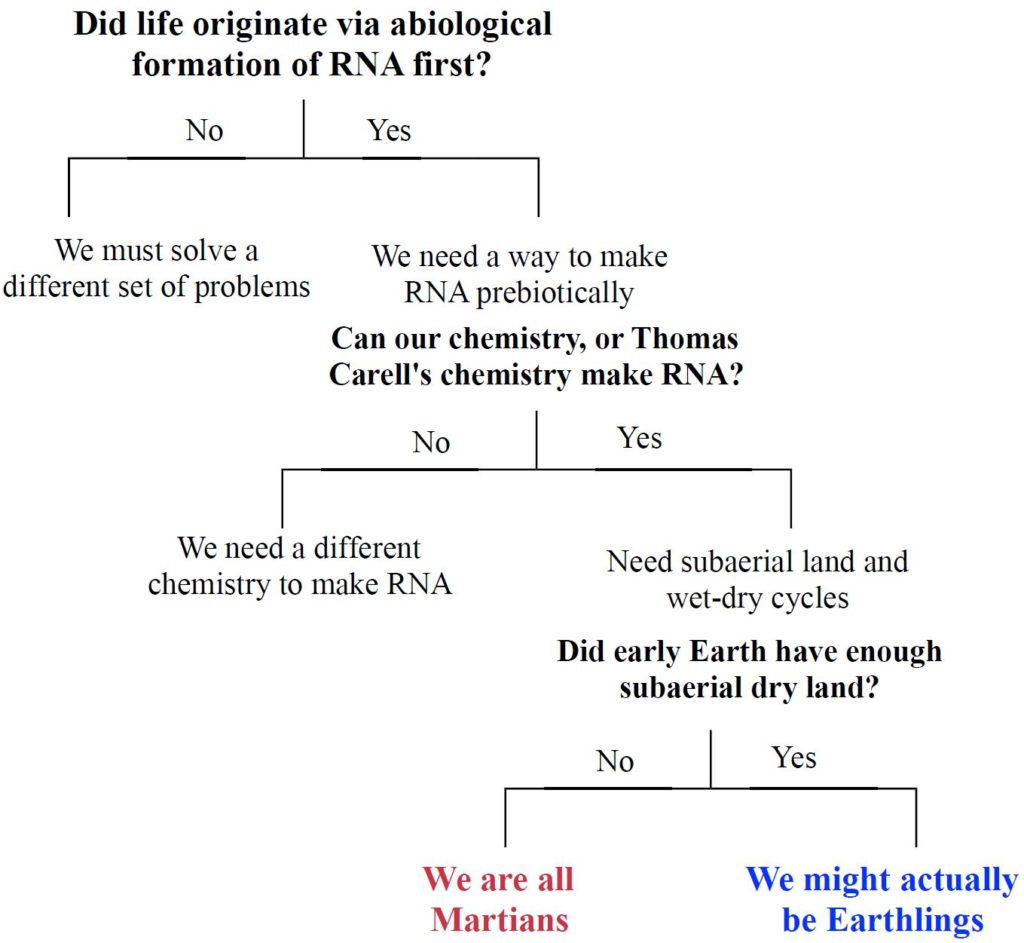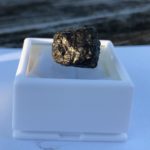Cite as: Benner, S. A. (2021) “If Earth was a Water World, then we are Martians”. Primordial Scoop, 2021, e0313. https://doi.org/10.52400/WGOO7791
It is difficult to ask how life originated. Not because it requires a super-collider or other expensive piece of equipment to answer the question. Not because it requires extraordinarily technical skills to explore possible answers.
No, the question is difficult because it does not fit into a “hypothesis testing” model that, as we all learned in middle school, is “the” scientific method. At one level, we are asking a historical question: How did it actually happen? At another level, we are asking a question in chemistry and geology: How might it have happened? Neither of these lend themselves to simple experimental design.
Accordingly, a decade ago, I wrote a book suggesting that progress towards answering the “origin of life” question would come not by inventing new theories for how life might have originated, but rather by addressing arguments that logically imply that life could not possibly have originated. As life certainly did originate, such arguments create apparent “paradoxes”.
One of these is the “water paradox”. It is especially painful to those who think that life began by the spontaneous biological synthesis of RNA on a Hadean Earth. The syllogism that generates the water paradox goes like this:
- RNA can operate only in water
- RNA cannot be formed in water
- Therefore, RNA cannot form abiologically in the only solvent where it can operate.
- Therefore, life could not have arisen via the abiological formation of RNA.
The premises actually have strong scientific grounding. As we have discussed elsewhere, RNA has a repeating charge in its backbone. Therefore, it dissolves easily in water, and pretty much nothing else. Further, that repeating backbone charge is essential to its ability to support Darwinian evolution. So RNA can work only in water.
We can expand the syllogism to have the premises apply to all genetic molecules. For example, we might say that all life requires an informational biopolymer with a repeating backbone charge. Since water is the only solvent that can dissolve an informational biopolymer with a repeating backbone charge, life must universally be in water.
Indeed, for many years, NASA, as it searched for life, used its mantra: “Follow the water.” Even though, every now and then, the “water paradox” is rediscovered, people still think that a search for water is a search for life.
So why can RNA not be formed in water? Briefly, because many of the chemical bonds that hold RNA together are unstable in water; they fall apart. Indeed, as you are reading this paragraph, these bonds are being broken in the RNA in your body because, as we know from Star Trek, we are all “ugly bags of mostly water“. Fortunately, you have evolved for eons to repair the bonds in your RNA (and DNA) that are broken by water.
Further, to make bonds that are unstable in water, energy must be added. This creates another problem: While biological processes very easily manage chemicals having energy, abiological processes do not.
That create something that we called the “tar paradox”, a frequently observed phenomenon in the kitchen. Adding energy to inanimate organic material does not generate life, but rather soot and asphalt. Material appropriate for paving roads.
To address the water paradox, we and others assembled schemes that form RNA on “subaerial land” (that is, land under the air) that is intermittently made wet, by rain, and then dried out. Death Valley in California is one such locale on Earth today. Here, bonds sensitive to water are formed during a dry spell. We then invoked minerals (such as borate and phosphate minerals) to prevent the organic material from wandering off to form tar.
Subaerial land has another advantage. Useful organic molecules generated by photochemistry high atmosphere can rain on to it. Thomas Carell has generated some important paths for getting those molecules.
In these models, after things dry out, compounds formed by atmospheric photochemistry and molecules assembling under control of borate minerals on dry land give RNA in paths that actually do not seem to be all that difficult.
So what is the problem? This week, Paul Voosen reported in Science that new studies reported in AGU Advances suggested that the Hadean Earth is entirely covered by water. No subaerial land. No solution to the water paradox that involves wet-dry cycles. Bummer.
“What about it?”, Paul evidently asked Thomas. Prof. Carell had an answer, related to a proposal from Korenaga and Bada a few years back: Volcanic islands would likely have poked their heads above the water even on a water world, offering at least some subaerial land for RNA to have been formed on early Earth.
This is one solution to the problem, but not a good one. If the amount subaerial land provided from volcanic islands was small, Earth would present only a small amount of surface area to support the origin of life.
But this is not the first time the water world problem has poked its head above the oceans that make the “origins question” difficult. A decade ago, Joseph Kirschvink at CalTech insisted to us that Earth was a water world, meaning that the water paradox could not be solved by our models, which presumed the presence of dry land on a Hadean Earth.
We had an answer, and it involved Mars. In an article entitled “The Case for a Martian Origin for Earth Life”, Hyo-Joong Kim and I noted that Mars never had an inventory of water comparable to Earth’s. Instead, Mars had dry land with intermittent water available during the time when life arose in our Solar System. Wet-dry cycles on the surface of Mars. With borate and phosphate minerals beneath a photochemically active atmosphere. More or less what is needed to form oligomeric RNA.
Further, material frequently moves Mars to Earth. Meteors strike Mars, and the impact ejects some Martian bio-rock into space. Some of it lands on Earth. I recently had a blog post that showed a piece of this material, collected as a meteorite from the Sahara desert.
Thus, any life that emerged on Mars on its wet-dry subaerial land would almost certainly have been transported to Earth. The impact energy and heating of the bulk of the material transfer is entirely compatible with survival of that life. The Mars rocks arrive on Earth fairly cold.
The logic tree follows naturally. Whether or not we need to invoke a Mars as a place for the origin of terran life depends on decisions made elsewhere in this logic tree.

Revisiting these thoughts is especially timely now that Perseverance has arrived on Mars. Sadly, its mission designers did not talk first to Jan Spacek, who would have told them the best way to look for life there.
But it is not too late. Elon Musk is planning to send to Mars the infrastructure needed to mine water on Mars. That water will be used to generate fuel for future human missions. Build and fly with it Jan’s “Agnostic Life Finder” (ALF), and we can learn just what biological chemistry with borate and phosphate minerals could do in an environment that certainly had subaerial land, atmospheric photochemistry, and wet-dry cycles.




Pingback: If we are related to Martians, how would we know (Part 2)? – The Primordial Scoop
Pingback: The Shadow Biosphere – The Primordial Scoop